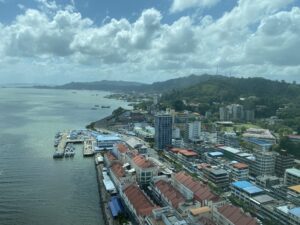
Borneo is the third largest island in the world, following Greenland and New Guinea, and belongs to three countries Malaysia, Brunei, and Indonesia. Sandakan, located in the state of Sabah in Malaysia, is home to a variety of wildlife, and I visited some of them on my recent travels.
Just as I completed this blog, I encountered updated information courtesy of the BBC. Due to COVID-19, the Sepilok Orangutan Rehabilitation Center is closed to protect the orangutans. Likewise, gorilla tourism in Rwanda, Uganda and the Democratic Republic of Congo is also suspended.
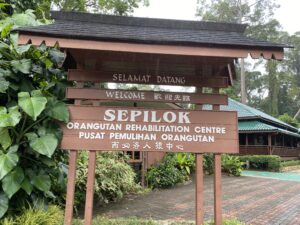
The Sepilok Orangutan Rehabilitation Center, founded in 1964, came about from the work of Barbara Harrisson (1922-2015), the first person to realize orphaned orangutans can be rehabilitated and returned to life in the forest. Harrisson began her work with orangutans on the the nearby island of Sarawak in 1956. Her husband Tom Harrisson was curator of the Sarawak State Museum.

At one time, baby orangutans were popular pets, at least until they grew into their strength. Collectors killed the mother to capture the baby. As laws were passed to conserve orangutans, it became harder to continue the trade. The forest department began giving confiscated baby orangutans to the museum. Harrisson brought them to his wife. Initially, she kept them in cages, but as she began observing orangutan behavior, Barbara Harrisson thought it would be possible to teach the orphans how to survive in the forest.
When the administrators in Sarawak declined to follow up on her suggestion, Harrisson moved her project to Borneo. The Orangutan Rehabilitation Center includes a nursery where visitors can view the young primates who can experience the same activities they will encounter in the jungle. The day I was there, a mother who grew up in the center had returned with her baby who was about two weeks old.

Mother with 2 week old baby 
Youngster practices climbing 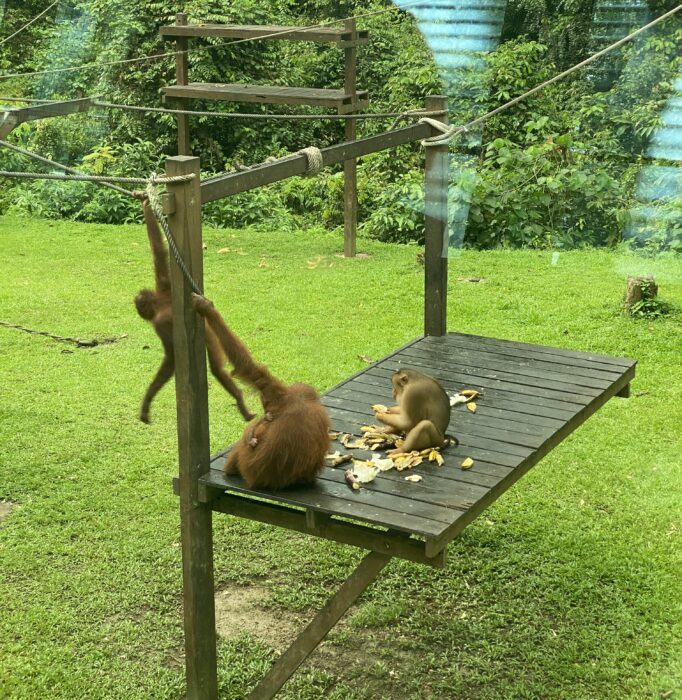
Youngsters feeding

Outside of the nursery adult orangutans are offered food on feeding platforms twice a day. The food is deliberately boring, so the orangutans won’t develop a preference for it. But they do come down from the trees to partake. This handsome fellow posed for his eager onlookers for about 20 minutes before turning around, as if to say, That’s enough.
SUN BEARS

Dr. Siew Wong founded the Bornean Sun Bear Conservation Center in 2008. The center opened to the public in 2014.
Sun Bears are the world’s smallest bear, about the size of a large dog, and are only found in Southeast Asia. The bears are black with tan snouts. They bark when alarmed. The have a unique tan chest patch which is compared to a sun burst. Hence the name Sun Bear. They’re also known as honey bears, and use their paws to scoop bee hives out of a tree.

There are 44 bears in the center. Most will be able to return to the jungle, but one is a permanent resident. Hunters killed this bear’s mother, and sold the cub as a pet before he even opened its eyes. He grew up with humans, and missed their company when he came to the center.
One day he injured himself. The center veterinarian treated him, and the bear learned that if he had an injury, he would receive human attention. So, he began harming himself. When the staff realized what the bear was doing, they knew that he would live his life at the center. The day I visited, Dr. Wong led the tour. The bear saw him, and began crying for attention which we were all happy to give him.
Proboscis Monkeys

The Proboscis Monkey is found only on Borneo, and may be a new species. The name derives from the prominent nose founded by the alpha male of a troop. At the Labuk Bay Proboscis Monkey Sanctuary, the monkeys have a protected habitat of 60 acres of mangrove swamp. The monkeys live along the river, are color blind, drink a lot of water, and eat leaves or fruit with a minimum of sugar content.
The sanctuary is on private land developed as a Palm Oil Plantation. In 1994 when the owner learned about the proboscis monkeys, he dropped plans to develop the entire sight. The sanctuary is open but not advertised. About 60 proboscis monkeys come to the feeding platforms, and before they finish their meal, the macaque monkeys drive them away.
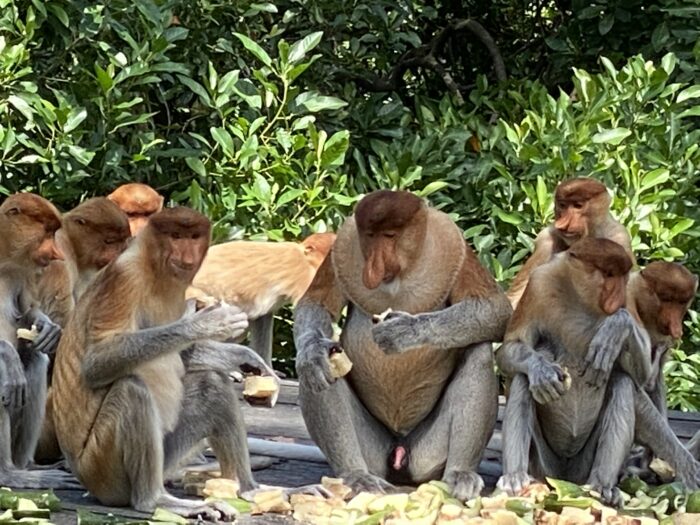
Proboscis monkeys feeding 
Mother with infantProboscis monkey 
An invading macaque monkey with her infant

The Lower Kinabatangan Segama Wetlands are accessed via the Abai River about an hour away from Sandakan Harbor. The wetlands cover over 788 km, and provide a protected home for the Kinabatangan Orangutan Conservation Project, crocodiles, pygmy elephants, and all manner of birds.
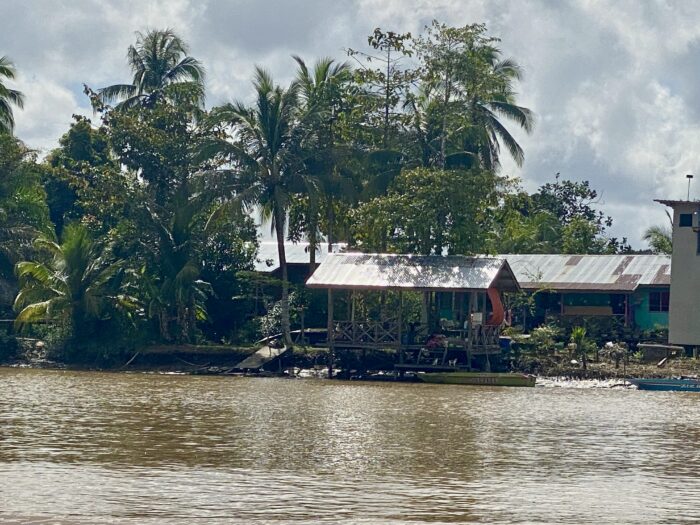
Abai Village 
Pygmy Elephant 
Boating on Abai River
I’m not sure why The Agnes Keith House is such a popular site for visitors to Borneo. The house itself is just an average bungalow. And most people don’t haven’t heard of American author Agnes Newton Keith, though she was once a popular writer. Her most well-known books are three memoirs she wrote about her years in Borneo: The Land Below the Wind about her life in Borneo before World War II; Three Came Home about life in Japanese prisoner of war camps, and White Man Returns about the immediate postwar period in Borneo. In 1950 Three Came Home became a movie starring Claudette Colbert as Agnes Keith.

As I toured the house, I realized I used Three Came Home as a source for a high school history paper. At the time, I certainly never expected to visit her house. The original house was destroyed during the war. In 1947 the Keiths rebuilt the house on the original foundation footprint. They named the house Newlands. After the Keiths departed in 1953, the house was used for various government officials and fell into disrepair. In 2001 the Sabah Museum Department restored the house an opened it as a museum.
Immediately next door where Agnes once kept her garden, the EnglishTea House serves “traditional English specialities and Asian favorites.” The owners play up the English colonial connection. A bagpiper greeted us. A 3-piece jazz band played 1920s. And there was a croquet set on the lawn.

Bagpiper 
Jazz Band setting up
🐒🐒🐒
Barbara Harrisson, 1995. By annechienbertheux
All other Photos by Author.
Labuk Bay Proboscis Monkey Sanctuary
Sepilok Orangutan Rehabilitation Centre
Emily Hahn. “Aping Motherhood.” Chicago Tribune. Aug. 7, 1988.
Bornean Sun Bear Conservation Centre.
English Tea House and Restaurant
Helen Briggs. “Coronavirus: Great apes on lockdown over threat of disease.” BBC. April 10, 2020.
Travel arrangements by Abercrombie & Kent

Sandra Wagner-Wright holds the doctoral degree in history and taught women’s and global history at the University of Hawai`i. Sandra travels for her research, most recently to Salem, Massachusetts, the setting of her new Salem Stories series. She also enjoys traveling for new experiences. Recent trips include Antarctica and a river cruise on the Rhine from Amsterdam to Basel.
Sandra particularly likes writing about strong women who make a difference. She lives in Hilo, Hawai`i with her family and writes a blog relating to history, travel, and the idiosyncrasies of life.

